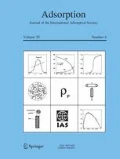Abstract
A series of activated carbons with varied surface chemistry, obtained by wet oxidation and thermal treatment, was used for the removal of penicillin from low concentration aqueous solution. It was found that the carbon surface chemistry favors the degradation of the antibiotic, giving rise to various intermediates detected both in solution and in the adsorbed phase (deposited with the pore structure of the activated carbons). The confinement of penicillin molecules entrapped in the nanopores of activated carbons of acidic nature accelerates their degradation compared to that one in the bulk solution, which can be linked the strong local pH fall inside the pores. Degradation also takes place in activated carbons of basic pH, although the nature and partition of the intermediates formed differ from those in the acidic carbons. In both cases most of the breakdown products do not present therapeutic activity.
Similar content being viewed by others
References
Aksu, Z., Tunc, O.: Application of biosorption for penicillin G removal: comparison with activated carbon. Process Biochem. 40, 831–847 (2005)
Al-Ahmad, A., Daschner, R.D., Kummerer, K.: Biodegradability of cefotiam, ciprofloxacin, meropenem, penicillin G, and sulfamethoxazole and inhibition of waste water bacteria. Arch. Environ. Contam. Toxicol. 37, 158–163 (1999)
Ania, C.O., Menendez, J.A., Parra, J.B., Pis, J.J.: Microwave-assisted regeneration of activated carbons loaded with pharmaceuticals. Water Res. 41, 3299–3306 (2007a)
Ania, C.O., Parra, J.B., Arenillas, A., Rubiera, F., Bandosz, T.J., Pis, J.J.: On the mechanism of reactive adsorption of dibenzothiophene on organic waste derived carbons. Appl. Surf. Sci. 253, 5899–5903 (2007b)
Arnott, I.A., Weatherley, L.R.: The stability of penicillin G during recovery by electrically enhanced extraction. Process Biochem. 30, 447–455 (1995)
Deshpande, A.D., Baheti, K.G., Chatterjee, N.R.: Degradation of β-lactam antibiotics. Curr. Sci. 87, 1684–1695 (2004)
Bandosz, T.J., Ania, C.O.: Surface chemistry of activated carbons and its characterization. In: Bandosz, T.J. (ed.) Activated Carbon Surfaces in Environmental Remediation. Interface Science and Technology, vol. 7, pp. 159–229. Elsevier, New York (2006)
Chaubal, M.V., Payne, G.F., Reynolds, C.H., Albright, R.L.: Equilibria for the adsorption of antibiotics onto neutral polymeric sorbents: experimental and modeling studies. Biotechnol. Bioeng. 47, 215–226 (2004)
Choi, K.J., Kim, S.G., Kim, S.H.: Removal of antibiotics by coagulation and granular activated carbon filtration. J. Hazard. Mater. 15, 38–43 (2008)
Daughton, C.G., Ternes, T.A.: Pharmaceuticals and personal care products in the environment: Agents of subtle change? Environ. Health Perspect. 107, 907–938 (1999)
De Weck, A.L., Eisen, H.N.: Some immunochemical properties of penicillenic acid: an antigenic determinant derived from penicillin. J. Exp. Med. 112, 1228–1247 (1960)
Figueiredo, J.L., Pereira, M.F.R., Freitas, M.M.A., Orfao, J.J.M.: Modification of the surface chemistry of activated carbons. Carbon 37, 1379–1389 (1999)
Gomez, M.J., Martinez-Bueno, M.J., Lacorte, S., Fernandez-Alba, A.R., Aguera, A.: Pilot survey monitoring pharmaceuticals and related compounds in a sewage treatment plant located on the Mediterranean coast. Chemosphere 66, 993–1002 (2007)
Gower, J.L., Risbridger, G.D., Redrup, M.J.: Positive and negative ion fast atom bombardment mass spectra of some penicilloic acids. J. Antibiot. 35, 33–43 (1983)
Graeser, M., Pippel, E., Greiner, A., Wendorff, J.H.: Polymer core-shell fibers with metal nanoparticles as nanoreactor for catalysis. Macromolecules 40, 6032–6039 (2007)
Hernando, M.D., Mezcua, M., Fernandez-Alba, A.R., Barceló, D.: Environmental risk assessment of pharmaceutical residues in wastewater effluents, surface waters and sediments. Talanta 69, 334–342 (2006)
Jones, O.A., Lester, J.N., Voulvoulis, N.: Pharmaceuticals: a threat to drinking water? Trends Biotechnol. 23, 163–167 (2005)
Kolpin, D.W., Furlong, E.T., Meyer, M., Thurman, E.M., Zaugg, S.D., Barber, L.B., Buxton, H.A.T.: Pharmaceuticals, hormones, and other organic wastewater contaminants in U.S. streams, 1999–2000: A national reconnaissance. Environ. Sci. Technol. 36, 1202–1211 (2002)
Li, D., Yang, M., Ju, J., Zhang, Y., Chang, H., Jin, F.: Determination of penicillin G and its degradation products in a penicillin products wastewater treatment plant and the receiving river. Water Res. 42, 307–337 (2008)
Mestre, A.S., Pires, J., Nogueira, J.M.F., Parra, J.B., Carvalho, A.P., Ania, C.O.: Waste-derived activated carbons for removal of ibuprofen from solution: role of surface chemistry and pore structure. Bioresour. Technol. 100, 1720–1726 (2009)
Ruiz, B., Cabrita, I., Mestre, A.S., Parra, J.B., Pires, J., Carvalho, A.P., Ania, C.O.: Surface heterogeneity effects of activated carbons on the kinetics of paracetamol removal from aqueous solution. Appl. Surf. Sci. 256, 171–5176 (2010)
Moats, W.A., Romanowski, R.D.: Determination of penicillin G in beef and pork tissues using an automated LC cleanup. J. Agric. Food Chem. 46, 1410–1413 (1998)
Noh, J.S., Schwarz, J.A.: Estimation of the point of zero charge of simple oxides by mass titration. J. Colloid Interface Sci. 130, 157–164 (1989)
Robberson, K.A., Waghe, A.B., Sabatini, D.A., Butler, E.C.: Adsorption of the quinolone antibiotic nalidixic acid onto anion-exchange and neutral polymers. Chemosphere 63, 934–941 (2006)
Schwartz, M.A.: Mechanism of degradation of penicillin G in acidic solution. J Pharm. Sci. 54, 472–473 (1965)
Zhou, L., Wang, S., Dai, W., Zhou, Y.: Intensified reaction of dilute thiophenes in nanoreactor. J. Phys. Chem. A 112, 1887–1890 (2008)
Author information
Authors and Affiliations
Corresponding author
Rights and permissions
About this article
Cite this article
Ania, C.O., Pelayo, J.G. & Bandosz, T.J. Reactive adsorption of penicillin on activated carbons. Adsorption 17, 421–429 (2011). https://doi.org/10.1007/s10450-010-9271-9
Received:
Accepted:
Published:
Issue Date:
DOI: https://doi.org/10.1007/s10450-010-9271-9



